Overview
Power Automate enables users to efficiently export data to Excel by automating workflows and minimizing manual errors through a structured step-by-step process. The article supports this by outlining specific actions, such as creating flows and mapping information, while emphasizing the benefits of reduced mistakes and increased productivity, demonstrated through real-world case studies and best practices.
Introduction
In the ever-evolving landscape of business technology, automation has emerged as a critical driver of efficiency and productivity. Power Automate stands at the forefront of this revolution, offering organizations a robust platform to streamline workflows and minimize manual tasks without requiring extensive coding knowledge.
With its ability to integrate seamlessly with various applications and services, Power Automate not only enhances operational efficiency but also empowers users to leverage data analytics for informed decision-making.
As businesses increasingly turn to automation to navigate the complexities of data management and operational processes, understanding the capabilities of Power Automate becomes essential.
This article delves into the intricacies of Power Automate, providing a comprehensive guide on its functionalities, best practices, and the transformative impact it can have on modern organizations.
Understanding Power Automate: The Key to Automation
Power Automate export to Excel serves as a powerful cloud-based platform designed to facilitate the automation of workflows between diverse applications and services. This tool empowers users to streamline repetitive tasks without requiring extensive coding expertise, thereby enhancing business productivity through Robotic Process Automation (RPA). By utilizing pre-built templates and a wide range of connectors, organizations can effortlessly design automated workflows that facilitate power automate export to Excel, significantly saving time and minimizing the potential for human error.
As emphasized in a recent case study, a mid-sized company enhanced productivity by automating information entry and legacy system integration, decreasing entry mistakes by 70% and boosting workflow productivity by 80%. This underscores the practical benefits of RPA in real-world applications. Additionally, tailored AI solutions can further enhance these processes by identifying the right technologies that align with specific business needs, thereby complementing the capabilities of RPA.
Moreover, as Thales observes,
-
46% of European companies keep all their data in the cloud,
highlighting the increasing dependence on cloud solutions for operational effectiveness. However, with 32% of cloud budgets squandered in 2022, there is a growing demand for efficient automation tools like Power Automate, especially for tasks such as export to Excel. The adoption of hybrid cloud infrastructures, particularly in the insurance industry, where 73% of organizations prefer this model, illustrates a shift towards flexible cloud solutions that can enhance operational efficiency.
With forecasts suggesting that the globe will retain 200 zettabytes of information by 2025, grasping the functionalities of automation tools becomes progressively essential. By leveraging this tool and integrating Business Intelligence, organizations can transform raw information into actionable insights, enhancing productivity, reducing operational costs, and ultimately driving better outcomes across their processes, making informed decisions that foster growth and innovation.
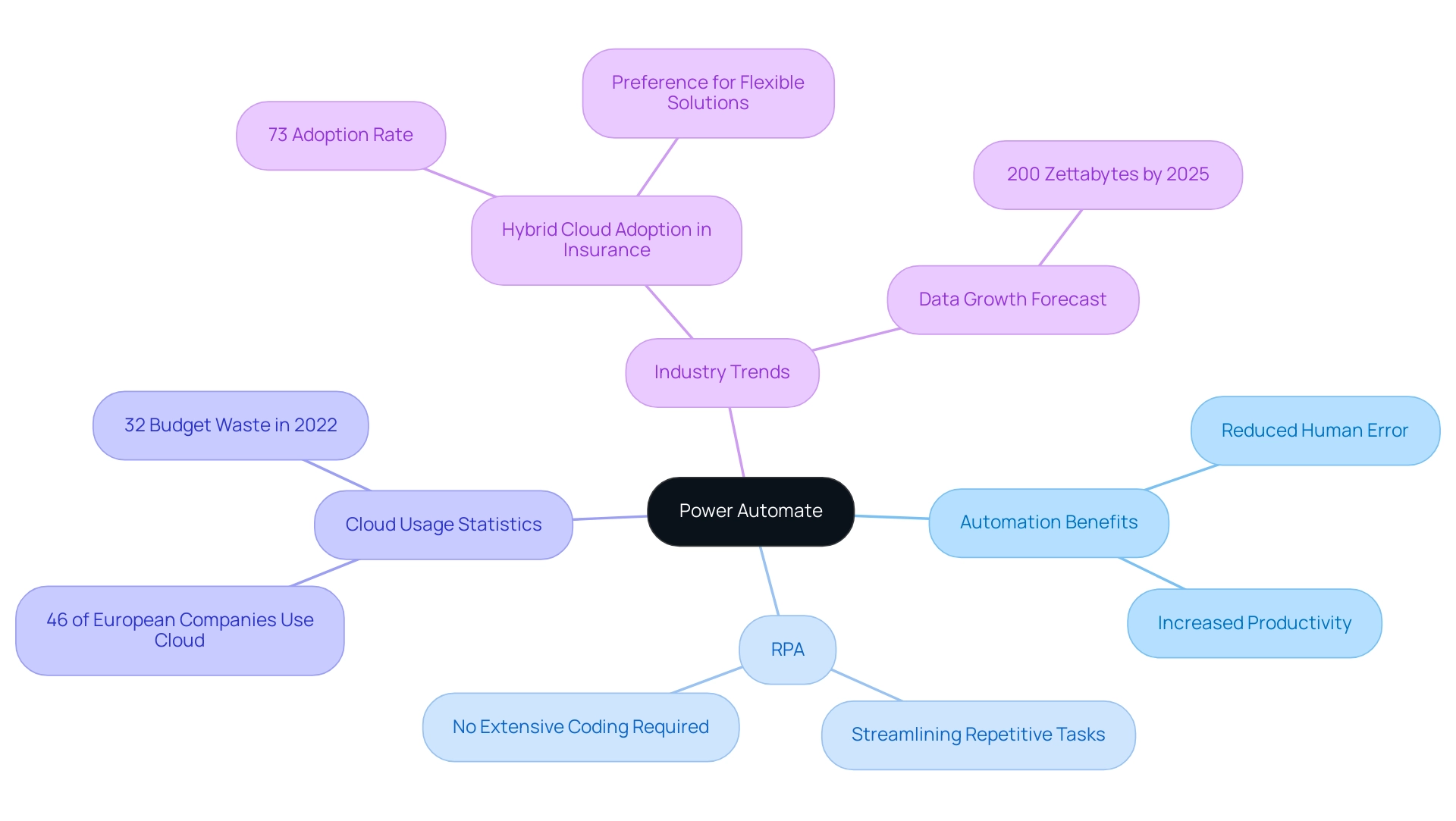
Step-by-Step Process for Exporting Data to Excel
Using power automate export to excel, exporting information to Excel is a straightforward process that not only improves operational efficiency but also harnesses the capabilities of Robotic Process Automation (RPA) to simplify manual workflows, minimize errors, and allow your team to focus on more strategic tasks. It’s important to note that Excel has a limitation of 1,048,576 rows per worksheet, which can influence your management strategy. Follow these steps to successfully carry out this task:
- Log into Flow: Begin by accessing your account at flow.microsoft.com.
- Create a New Flow: Click on ‘Create’ and select either ‘Instant flow’ or ‘Scheduled flow’ according to your specific requirements.
- Select a Trigger: Choose an appropriate trigger that will set off the flow, such as ‘When an item is created’ in SharePoint, ensuring that the process responds to real-time events.
- Add an Action: Click on ‘New step’, search for ‘Excel’, and pick ‘Add a row into a table’. This action is pivotal for the information export process, demonstrating how power automate export to excel enhances productivity by automating repetitive tasks and minimizing the potential for human error.
- Configure Excel Action: Specify the location of your Excel file and select the table where the information will be integrated, benefiting from the enhanced integration capabilities introduced in the latest Power Automate updates.
- Map the Information: Align the information fields from your trigger to the corresponding columns in your Excel table, ensuring accurate representation.
- Test Your Flow: Save your flow and execute a test to confirm that the information exports correctly and meets your operational needs.
- Monitor the Flow: Finally, review the run history to ensure successful execution, and troubleshoot any issues that may arise, as common errors can impede the efficiency of information export workflows.
Utilizing tools like Flow allows for seamless integration of information, which is crucial in today’s information-rich environment. As Uber stated, ‘We knew we needed an accurate and reliable source of real-time flight data… we’re confident that OAG is the right partner.’ This emphasizes the significance of having reliable information sources in your operations.
Furthermore, in a case study centered on collecting case overview statistics in Process Mining, various metrics such as new events, active cases, case duration, and utilization were highlighted, showcasing the practical benefits and outcomes of utilizing this tool for information management. By adhering to this guide, you can effectively utilize the features of the automation tool and RPA, including Power Automate export to Excel, to simplify your export procedures, boost business efficiency, and obtain a competitive edge through insights based on information.
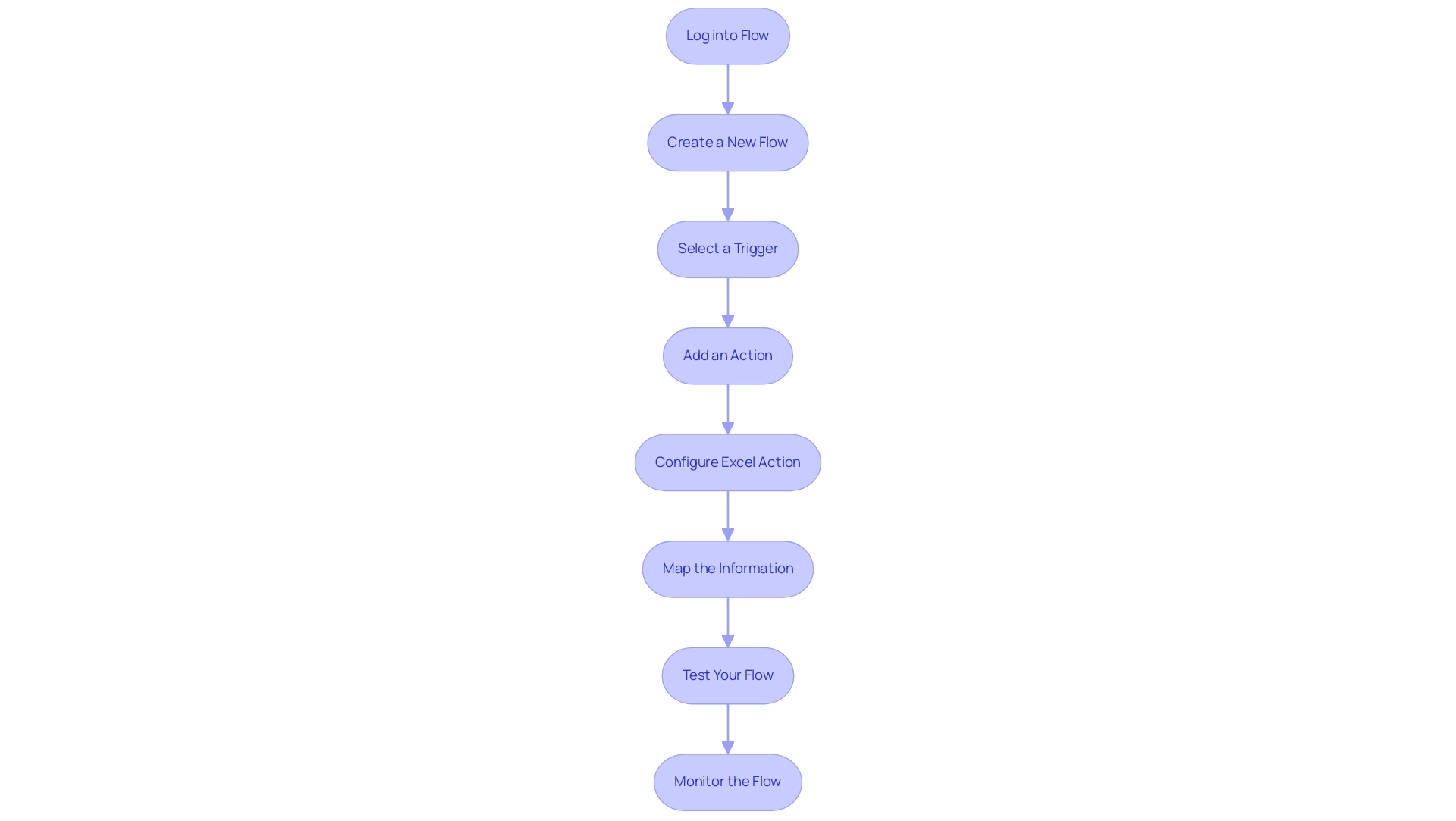
Troubleshooting Common Export Issues
Transferring information via automation can be effective, yet individuals frequently encounter various obstacles that impede the procedure. Understanding these common issues is crucial for successful automation:
-
Connection Errors: A frequent hurdle is ensuring that the connection to Excel is correctly configured. Verify authentication settings and permissions to avoid disruption.
Statistics show that Power Automate interprets 500 errors thrown by connectors as a BadGateway error, complicating troubleshooting efforts. Overcoming these connectivity challenges is vital for maintaining operational efficiency, especially in a landscape where workflows are streamlined through power automate export to excel.
-
Information Mapping Issues: When information fails to appear in Excel, it’s essential to check that fields are appropriately mapped. Confirm that the column names in Excel match the information being sent to prevent miscommunication. Effective information mapping is a critical component of leveraging Business Intelligence for informed decision-making.
-
File Permissions: Permissions play a vital role in the export process. Ensure you have the necessary rights to write to the Excel file. If the file is stored in OneDrive or SharePoint, reviewing sharing settings is crucial to maintain access. Addressing file permission issues can significantly enhance the efficiency of your automated workflows, particularly when you utilize power automate export to excel.
-
Flow Failures: In the event of a flow failure, consult the run history for specific error messages. This feedback can guide adjustments to your flow, ensuring it aligns with the intended output. Utilizing RPA effectively involves continuous monitoring and refinement of these flows, with the final steps including saving the flow and testing the extraction process to ensure it works correctly for the power automate export to excel. This step is essential to confirm that all configurations are properly set and the information exports as intended. Tim Weinzapfel, an expert in Automation and Analytics, highlights the importance of addressing these issues, stating, > A big thanks to Colin Tomb for inquiring on this and I’m hoping this is useful. Such insights are invaluable as organizations navigate the complexities of power automate export to excel. Additionally, when a CSV file is created in SharePoint during this process, it includes a filename with the current date in ‘MM-dd-yyyy’ format, which helps in organizing exported data effectively. To illustrate the potential impact of resolving these challenges, consider the case of Stratos Wealth Partners, which implemented Encodian to streamline client agreement management. Their transformation resulted in improved productivity and operational advancements, highlighting the advantages of effectively tackling export challenges and utilizing RPA and Business Intelligence for business growth. Furthermore, tailored AI solutions can provide additional support in automating these processes, ensuring smoother operations and reducing the likelihood of errors, ultimately freeing up teams for more strategic work.
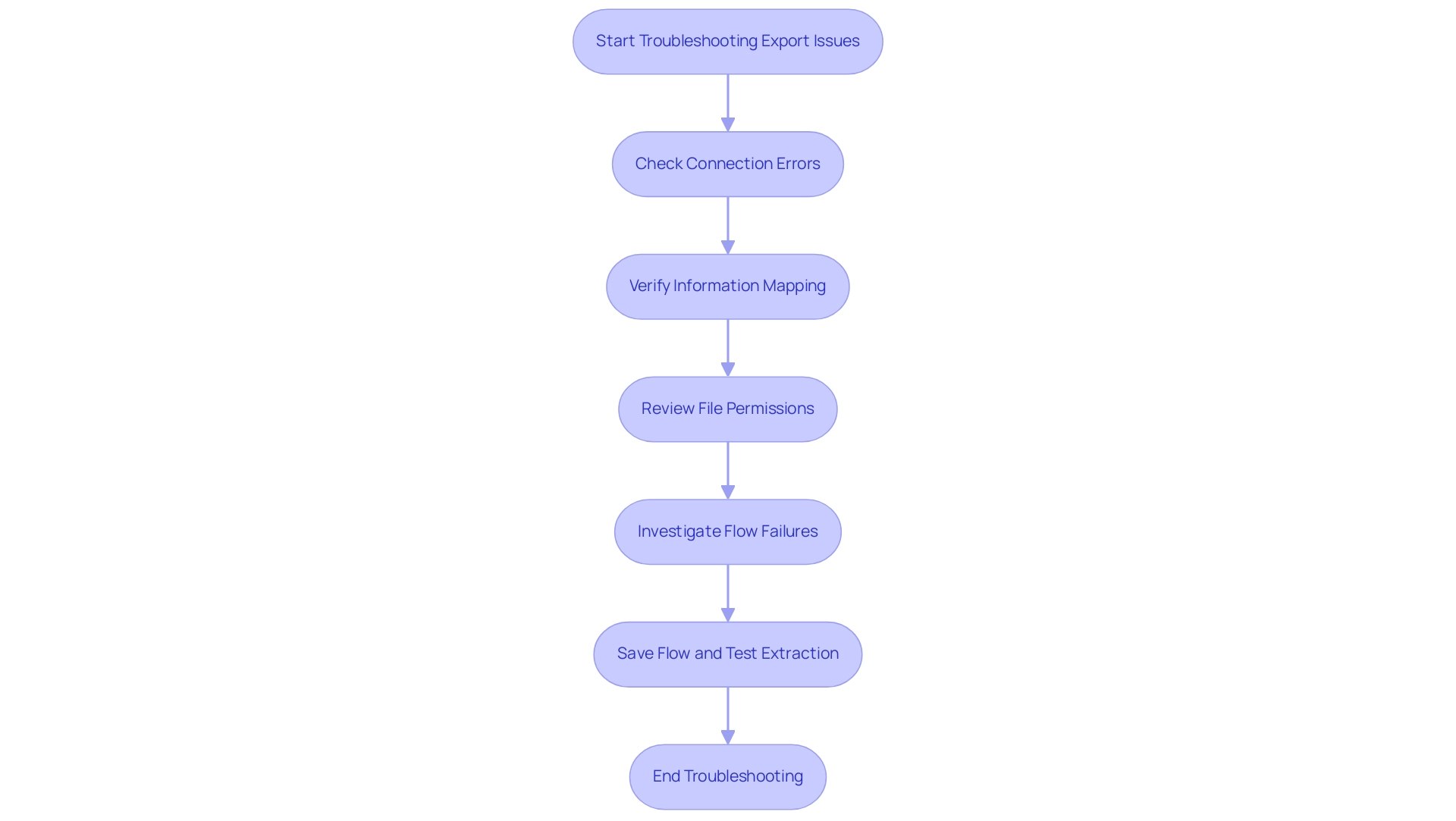
Best Practices for Efficient Use of Power Automate
To maximize efficiency with Power Automate, implementing the following best practices can significantly enhance your workflows:
- Start Small: Initiate your journey with simple automations to gain familiarity with the tool. This approach allows you to build confidence before advancing to more complex workflows.
- Utilize Templates: Take advantage of the myriad pre-built templates in Power Automate, especially those designed for power automate export to excel. These templates not only save time but also provide insights into best practices derived from existing workflows, making them an invaluable resource for efficiency.
- Regularly Review Flows: Consistently assess and update your flows to ensure they remain effective and relevant, particularly after changes in source information or connected applications. This proactive approach can prevent potential bottlenecks and inefficiencies.
- Document Your Flows: Thorough documentation of your flows, including their purposes and operational details, is crucial. This practice aids in maintenance and facilitates onboarding for new team members, ensuring continuity and clarity in operations.
- Engage in Continuous Learning: Keep abreast of the latest features and best practices by actively participating in Power Automate communities and utilizing available resources. As Cornellius Yudha Wijaya, a data science assistant manager, aptly states,
AI has become a tool that certainly helps our data analysis process.
This sentiment highlights the transformative potential of automation tools in optimizing workflows and improving operational effectiveness.
Moreover, leveraging Robotic Process Automation (RPA) to automate manual workflows can further improve operational performance in today’s rapidly evolving AI landscape. A pertinent case study named ‘Streamlining Operations with GUI Automation’ demonstrates how a mid-sized company enhanced productivity by automating information entry, software testing, and legacy system integration. They decreased entry mistakes by 70%, sped up testing processes by 50%, and enhanced workflow efficiency by 80%, achieving ROI within 6 months.
This example exemplifies how tailored AI solutions and Business Intelligence can drive informed decision-making and enhance productivity.
Additionally, it is noteworthy that for a table containing 2 million rows, statistics are updated every 44,721 modifications, emphasizing the importance of maintaining accurate information for effective automation. Business Intelligence plays a crucial role in transforming this raw data into actionable insights, enabling organizations to make informed decisions that drive growth. By following these best practices, organizations can significantly enhance their automation initiatives, ensuring that the power automate export to Excel is utilized to its fullest potential while adapting to evolving operational requirements.
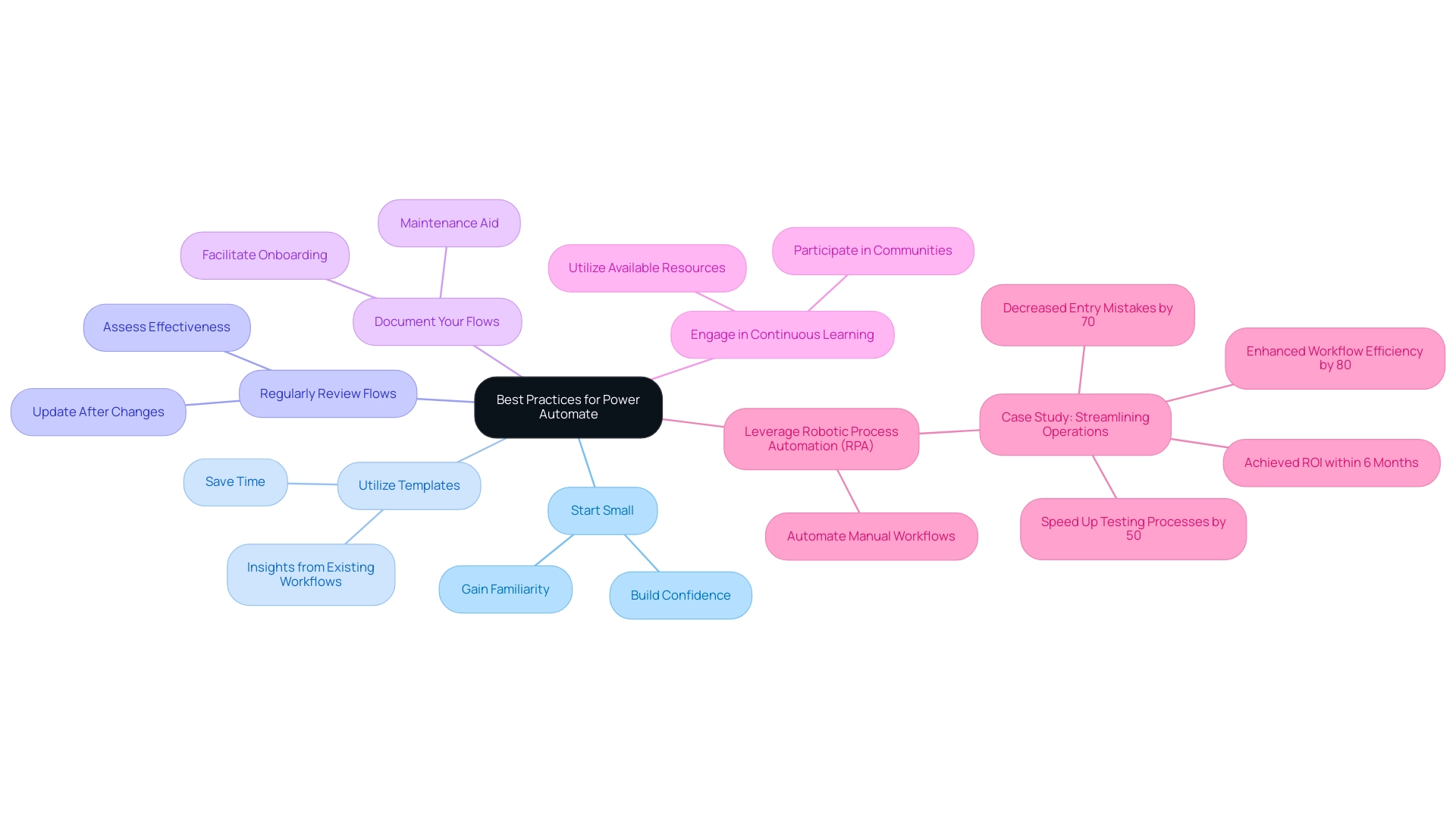
Integrating Power Automate with Other Tools for Enhanced Functionality
This automation solution stands out for its capacity to seamlessly connect with a diverse range of tools and platforms, significantly enhancing operational functionality and efficiency. Key integrations include:
- Microsoft 365: Connect with essential applications such as Outlook, SharePoint, and Teams to streamline communication and automate collaboration tasks. This integration is particularly beneficial, as it allows for real-time updates and enhanced teamwork, leading to more informed decision-making.
- CRM Systems: Integrate with leading platforms like Salesforce and Dynamics 365 to automate customer relationship management processes.
With a significant rise in usage rates anticipated for 2024, utilizing the automation solution for CRM tasks can enhance customer interactions and improve information accuracy, while also sending alerts if sales fall below a specified threshold to boost operational efficiency.
- Information Services: Employ connectors for services like Azure SQL Database or Google Sheets to automate information retrieval and processing, which can lead to more effective information management and reporting, essential for utilizing Business Intelligence.
- Social Media: Automate postings and interactions on social media platforms such as Twitter and Facebook, improving digital engagement without manual effort, thus freeing up resources for more strategic activities.
- Custom APIs: For advanced users, the automation solution provides the flexibility to create custom connectors, allowing for integration with proprietary systems. This capability fosters tailored automation solutions that directly meet unique business needs.
Additionally, the 3-Day BI Sprint enables teams to quickly create professionally designed reports, while the General Management App provides comprehensive management and smart reviews, enhancing the overall data reporting experience.
A relevant case study on Risk Management illustrates how organizations can use Automate to collect data on potential risks and feed it into BI for comprehensive analysis, enabling proactive risk mitigation strategies through detailed risk analysis reports.
As Caroline Mayou aptly states,
Their primary role is to bridge the gap between the technical potential of Automate and the practical needs of your business, ensuring that your investment in automation yields measurable outcomes.
This highlights the importance of aligning technical integrations with operational goals to achieve significant efficiency gains. Furthermore, it’s important to note that users must have Power BI Pro or Premium licenses to share dashboards and reports, which is crucial for maximizing the benefits of these integrations.
By focusing on Business Intelligence and Robotic Process Automation, organizations can enhance productivity and drive data-driven insights that foster growth and innovation.
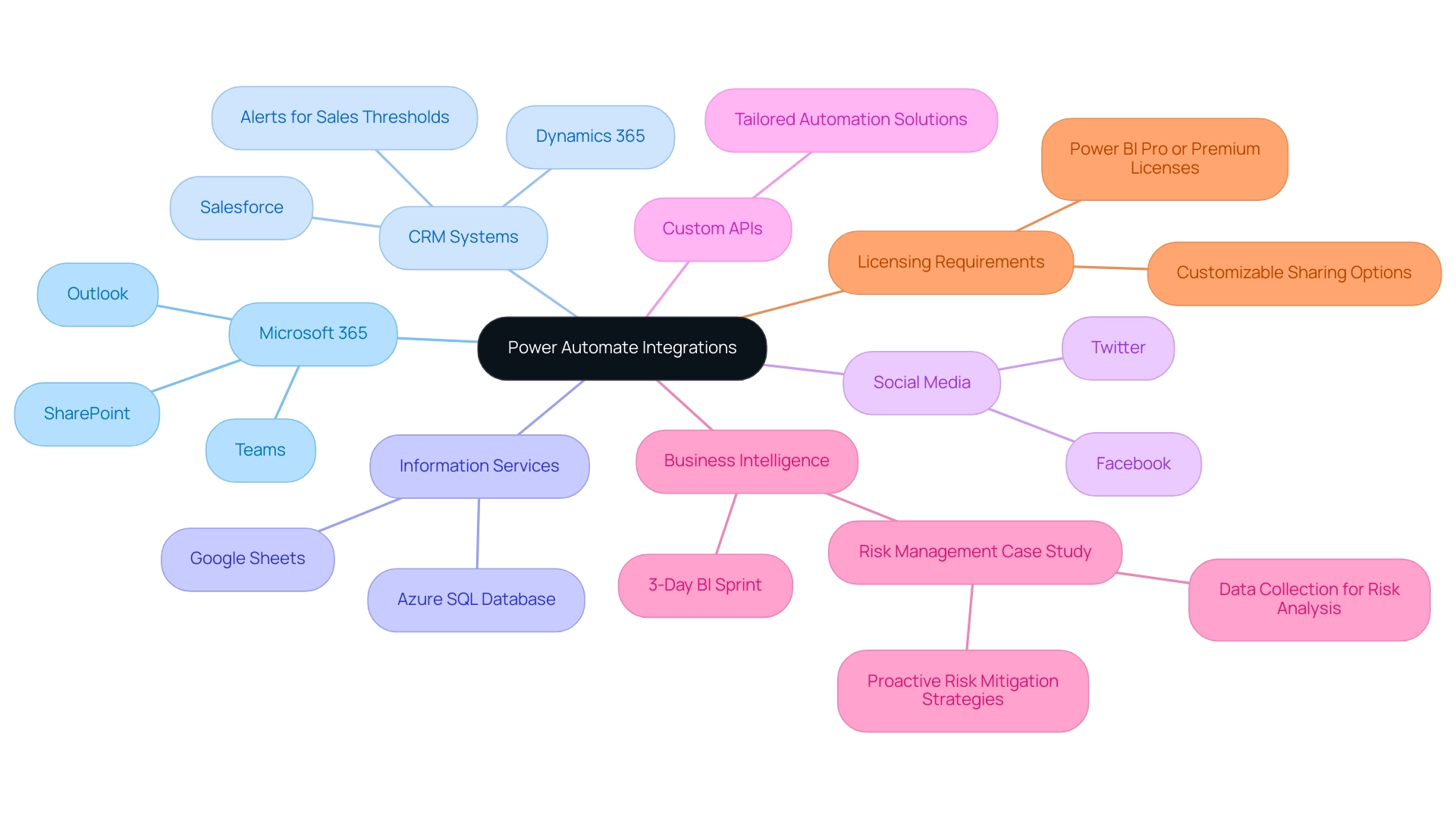
Conclusion
Power Automate offers organizations a powerful solution to streamline workflows and enhance productivity through automation. By simplifying the process of integrating diverse applications and services, it enables users to tackle repetitive tasks efficiently without the need for extensive coding skills. As discussed, the platform’s capabilities extend beyond basic automation, incorporating Robotic Process Automation (RPA) and Business Intelligence to drive informed decision-making and operational efficiency.
The step-by-step approach to exporting data to Excel illustrates how easy it is to harness the full potential of Power Automate to improve data management and reporting. Addressing common export issues and adhering to best practices further ensures that organizations can maximize their investment in this technology. By engaging in continuous learning and utilizing pre-built templates, users can build confidence and enhance their automation strategies over time.
Ultimately, the seamless integration of Power Automate with various tools not only enhances operational functionality but also fosters collaboration and data-driven insights. As organizations navigate the complexities of today’s data-rich environment, leveraging the capabilities of Power Automate becomes essential for driving growth and innovation. By embracing automation, businesses position themselves to thrive in an increasingly competitive landscape, transforming their operations and achieving significant efficiency gains.

